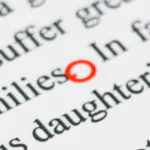
Proofreading Tips: How to Proofread Quotations
Academic writing accounts for a significant portion of many freelance proofreaders’ work. And, along with some other non-fiction, academic writing often relies heavily on quotations. It is thus important to know how to proofread quotations. In this post, we give an overview of things to consider when proofreading quotations in academic or other non-fiction writing.
Single or Double Quotation Marks?
Typically, UK and Australian English use ‘single’ quotation marks (otherwise known as inverted commas), while US English uses “double” quotation marks. This is just a trend, and some publications and organizations prefer double quotation marks in UK English (especially in the publishing industry). It is rarer for US English to use single quotation marks, but not impossible. As such, you should always check your client’s style guide on this issue.
It’s also worth remembering that, when a quotation contains a quotation, the author should use the opposite style of quotation marks. For example:
Smith (2009, p.24) states, ‘Quotation marks are more than just “punctuation”.’
Smith (2009, p.24) states, “Quotation marks are more than just ‘punctuation.’”
The most important thing, though, is ensuring that quotation marks in a document are used consistently and, where relevant, in line with what your client’s style guide recommends.
Punctuating Quotations
UK English tends to favor placing periods and commas inside quotation marks when part of the quoted material (but outside when not), while US English always places them inside.
Other terminal punctuation (e.g., question marks) goes inside or outside the quotation marks depending on whether it is part of the quotation or the surrounding text. For example:
Lawrence (2012, p.73) asks, ‘How should quotations be punctuated?’
But did the inventor of quotation marks ‘save us from confusion’ (Nelson, 1929, p.12)?
Again, though, these are just broad trends in the dialects mentioned. As such, your main duty as a proofreader will be checking that quotations are punctuated consistently and that any instructions in your client’s style guide have been followed correctly.
Capitalizing Quotations
Typically, the first word of a quotation should be capitalized when it is a full sentence:
Smith (2009, p.27) goes on to say, ‘The best punctuation mark by far is the quotation mark’.
If only part of a sentence is quoted, it should not be capitalized:
Howard (2001, p.58) retorts that the quotation mark is ‘the most annoying punctuation mark’.
Introducing Quotations
Proofreading quotations may also mean checking they fit smoothly with the surrounding text. The author can achieve this in different ways depending on the situation.
If a quote is introduced with a verb like says, argues, or claims, there should be a comma before the opening quotation mark. For instance:
Jones (2010, p.3) argues, ‘Smith has an unhealthy obsession with quotations’.
But the comma is not required if the quotation is preceded by the word that:
Jones (2010, p.3) argues that ‘Smith has an unhealthy obsession with quotations’.
If a quote follows from a complete sentence, meanwhile, it is usually preceded by a colon:
He goes on to raise a valid question: ‘Should Smith get medical help?’ (Jones, 2010, p.5).
Additionally, fragments and individual words can be quoted in the middle of a sentence without being preceded by any punctuation. For example:
Jones (2010, p.6) wonders if Smith is ‘dangerously obsessed’ and recommends ‘caution’.
Block quotes are a little different. They are often introduced with a colon, especially when they follow from a complete sentence. And this is a good default position to rely on if you’re not sure how to present block quotations otherwise. However, some style guides recommend introducing a block quotation with a period, comma, or without any punctuation at all (i.e., so that the block quote follows from and completes the introductory sentence).
In all cases, though, block quotations should then start on a new line and be indented from the margin to make the quote stand out from the main text (although, if applicable, you may want to check your client’s style guide again for advice on other aspects of formatting).
Modifying Quotations
Authors may choose to modify the quotations they use because:
- The original quote contains an error and they want to correct it.
- They want to modify part of the quote to make it fit better with the surrounding text.
- They want to omit part of the quotation.
The rules for this can vary a lot depending on the style guide, though.
Where the original source material contains an error, or an archaic or non-standard spelling, it can sometimes be corrected without comment or without marking the change (as long as the correction doesn’t change the meaning of the quoted text).
In other cases, authors may change quotations slightly for the sake of clarity, or the style guide they are using might require authors to mark any change they make to quoted text, even minor corrections. In such circumstances, the typical solution is to add square brackets to indicate where a change was made. For example:
Jones claims that ‘[Smith] should not be allowed around academic documents’.
Here, we can assume that the author has changed he to Smith. The main thing here is that amended quotations should retain the meaning of the original.
Authors may also add notes in square brackets:
‘Smith and Jones, despite everything, were not the best of friends [emphasis added]’.
And to indicate that material has been omitted, an author may use an ellipsis:
‘Smith and Jones were … not the best of friends’.
The rules for using ellipses like this vary among style guides, though (e.g., how to space ellipses, whether to place them within square brackets), so it’s worth checking how to do this.
Finally, there are occasions when an author needs to preserve an apparent error in a quotation, but they also want to mark that the mistake is not something they’ve introduced. When this occurs, the standard solution is to add the Latin term sic in square brackets:
At this point Smith says, ‘quotations R [sic] the best!’
This is less common in modern writing, though, where most errors in quotations are just corrected, so make sure to check your client’s style guide if you see [sic] in the text. And if you spot a typo in a quotation, make sure to comment on it and suggest an appropriate solution.
Tips for Proofreading Quotations
Under most circumstances, you will not be expected to make changes to the content of quotes. But there are some things you can do if you spot what you think is an error:
- If you suspect the author has made an error when copying or typing the quoted material, leave a comment asking them to check it.
- If there is a clear typo (e.g., hwere instead of where), correct it but leave a comment for the client to check the source material.
- If the quote comes from an accessible website, you could look it up. But this can be risky (especially if the quotation has been translated).
For more common errors relating to quotation marks, check out this post.
Becoming A Proofreader
If you’d like to know more about proofreading, you can find everything you need in our Becoming A Proofreader course. You can try it for free before you commit, and if you pass with a mark of 80% or more you are guaranteed work with our partner company, Proofed!



Join the Conversation
Leave a Comment
Your email address will not be published.